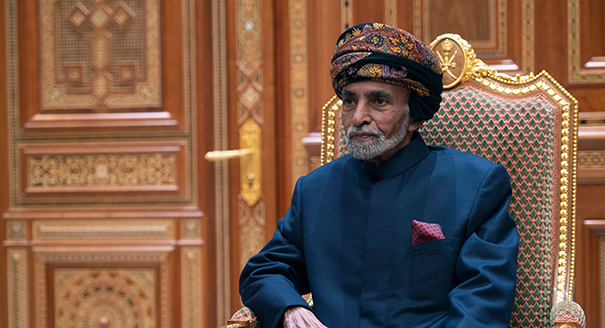What Happened?
On January 10, Sultan Qaboos bin Sa‘id Al Sa‘id, the world’s third longest serving monarch, passed away. His death paved the way for the one of the most transparent and orderly succession processes in modern Arab history. Within hours of publishing his obituary on January 11, the state efficiently organized his funeral and swore in the new sultan, Haitham bin Tariq, sending a message about Oman’s ongoing stability and its intent to live by Qaboos’ legacy.
Why Does It Matter?
Oman is a well regarded voice of peace and moderation in an unstable region. Its neutral foreign policy and able skills of facilitation and mediation are globally recognized and sought after. Since Sultan Qaboos alluded to his sickness in 2014, there had been much anticipation about Oman’s future and the sustainability of its unique brand. Compounding the anxiety was Oman’s distinctive succession model, influenced by the Ibadi ethos of choosing, as opposed to appointing, an heir. The only state in the world dominated by the Ibadi school of Islam, Oman had translated this tradition in Article 6 of its Basic Statute issued in 1996, which it activated for the first time after the sultan’s death.
The Ruling Family Council had three days to choose a ruler. Had it failed to do so at the end of the designated period, this would have activated a second scenario of opening Qaboos’ hand-written, sealed letter identifying his nominee for a successor. What transpired did not adhere to the letter of the law. The family promptly relinquished its right to choose a ruler and asked the Defense Council to open and observe Qaboos’ will “in acknowledgment, appreciation, and gratitude for the late sultan.”
At the first opportunity to show its independent leadership, the ruling family opted instead to rely on Qaboos’ grand legacy. This further cemented the legitimacy of the new sultan as Qaboos’ handpicked choice, thereby providing a sense of continuity. The family acted with the same swiftness, determination, and discretion that had marked Qaboos’ rule, foreshadowing its design for the post-Qaboos era. The decision of the ruling family made Oman’s succession no different from those of its Gulf neighbors, where the ruler names his heir—though, unconventionally, it aired the proceedings on television and delivered it through a letter. The transparency, speed, and success in addressing the succession was a model for many neighboring states who face imminent transitions of power.
What Are the Implications for the Future?
Qaboos has chosen a person who resembles him. Haitham bin Tariq is a quiet man, an Anglophile, and an Oxford graduate. He is a tried administrator who has served in various government positions and who is deeply interested in economic issues, especially Oman Vision 2040, a road map for national social and economic planning for the coming two decades. In that way Qaboos sent a message of reassurance through his last act. By selecting a cousin who worked in the Foreign Ministry for sixteen years, the late sultan ensured that his foreign policy would remain unchanged.
In his first speech as sultan, Haitham bin Tariq promised to abide by what can be called the Qaboos Doctrine, a set of five inter-related principles: “[P]eaceful coexistence with nations, good neighborliness, non-interference in the affairs of others, respect for countries’ sovereignty, and international cooperation in various spheres.”
Oman has benefited from cultivating this doctrine. It has been wisely implementing its tenets without Qaboos’ close supervision since his illness in 2014. To think that Oman will steer away from that course is misguided. What could be different, though, is the reaction of regional states that may test the new leadership to determine whether there is room for swaying Oman’s foreign policy. Given Oman’s past record, change on this front is highly unlikely.
If the Qaboos Doctrine is carefully pursued in foreign policy, the new ruler can leave his imprint on the domestic front. Haitham is a family man who is not as reclusive as his predecessor. Will he govern by consolidating power like Qaboos, who held the positions of prime minister as well as minister of defense, finance, and foreign affairs? Or will he appoint a prime minister and govern in a decentralized fashion? Will he revive his predecessor’s annual country tours or devise a new mechanism for interacting with the people? Haitham’s next policy moves and government formation will provide a telling answer. So will his decision to uphold or tweak the succession model.
Haitham has a solid domestic platform upon which to build. Oman is a success story when it comes to its forward-thinking religious discourse and acceptance of differences, which has helped prevent Omanis from joining extremist groups. Having overseen the Ministry of Heritage and Culture for seventeen years, the new sultan is part of this success story. With no risk of family infighting, tribal competition, or secessionist aspirations, Haitham can turn his attention to the economy.
Qaboos built a modern state from scratch, earning him the label as “the architect of Oman’s renaissance.” Today, Omanis expect their lives to improve and look forward to effective economic reforms. Haitham needs to address Oman’s rising unemployment and guarantee a dignified living for all Omanis. That will be a key contribution allowing him to build his own legacy. Will the new sultan be able to pull an Omani renaissance 2.0? Time will tell.








